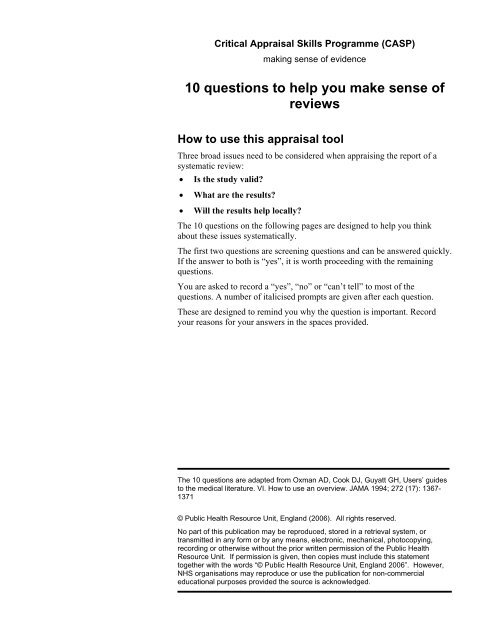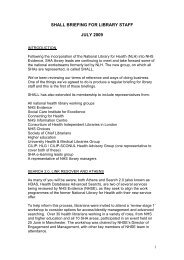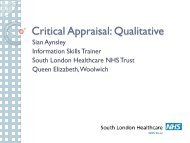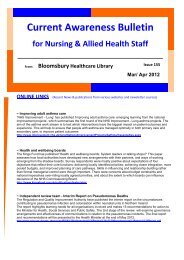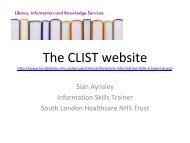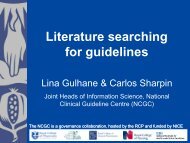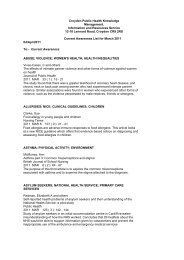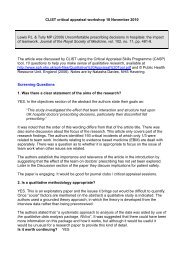Critical Appraisal Skills Programme (CASP) - JISCMail
Critical Appraisal Skills Programme (CASP) - JISCMail
Critical Appraisal Skills Programme (CASP) - JISCMail
You also want an ePaper? Increase the reach of your titles
YUMPU automatically turns print PDFs into web optimized ePapers that Google loves.
<strong>Critical</strong> <strong>Appraisal</strong> <strong>Skills</strong> <strong>Programme</strong> (<strong>CASP</strong>)<br />
making sense of evidence<br />
10 questions to help you make sense of<br />
reviews<br />
How to use this appraisal tool<br />
Three broad issues need to be considered when appraising the report of a<br />
systematic review:<br />
• Is the study valid?<br />
• What are the results?<br />
• Will the results help locally?<br />
The 10 questions on the following pages are designed to help you think<br />
about these issues systematically.<br />
The first two questions are screening questions and can be answered quickly.<br />
If the answer to both is “yes”, it is worth proceeding with the remaining<br />
questions.<br />
You are asked to record a “yes”, “no” or “can’t tell” to most of the<br />
questions. A number of italicised prompts are given after each question.<br />
These are designed to remind you why the question is important. Record<br />
your reasons for your answers in the spaces provided.<br />
The 10 questions are adapted from Oxman AD, Cook DJ, Guyatt GH, Users’ guides<br />
to the medical literature. VI. How to use an overview. JAMA 1994; 272 (17): 1367-<br />
1371<br />
© Public Health Resource Unit, England (2006). All rights reserved.<br />
No part of this publication may be reproduced, stored in a retrieval system, or<br />
transmitted in any form or by any means, electronic, mechanical, photocopying,<br />
recording or otherwise without the prior written permission of the Public Health<br />
Resource Unit. If permission is given, then copies must include this statement<br />
together with the words “© Public Health Resource Unit, England 2006”. However,<br />
NHS organisations may reproduce or use the publication for non-commercial<br />
educational purposes provided the source is acknowledged.<br />
© Public Health Resource Unit, England (2006). All rights reserved.
Screening Questions<br />
1. Did the review ask a clearly-focused question? Yes Can’t tell No<br />
Consider if the question is ‘focused’ in terms of:<br />
– the population studied<br />
– the intervention given or exposure<br />
– the outcomes considered<br />
2. Did the review include the right type of study? Yes Can’t tell No<br />
Consider if the included studies:<br />
– address the review’s question<br />
– have an appropriate study design<br />
Is it worth continuing?<br />
Detailed Questions<br />
3. Did the reviewers try to identify all Yes Can’t tell No<br />
relevant studies?<br />
Consider:<br />
– which bibliographic databases were used<br />
– if there was follow-up from reference lists<br />
– if there was personal contact with experts<br />
– if the reviewers searched for unpublished studies<br />
– if the reviewers searched for non-English-language<br />
studies<br />
4. Did the reviewers assess the quality of the Yes Can’t tell No<br />
included studies?<br />
Consider:<br />
– if a clear, pre-determined strategy was used to<br />
determine which studies were included. Look for:<br />
– a scoring system<br />
– more than one assessor<br />
© Public Health Resource Unit, England (2006). All rights reserved.
5. If the results of the studies have been Yes Can’t tell No<br />
combined, was it reasonable to do so?<br />
Consider whether:<br />
– the results of each study are clearly displayed<br />
– the results were similar from study to study<br />
(look for tests of heterogeneity)<br />
– the reasons for any variations in results are<br />
discussed<br />
6. How are the results presented and what is<br />
the main result?<br />
Consider:<br />
– how the results are expressed (e.g. odds ratio,<br />
relative risk, etc.)<br />
– how large this size of result is and how<br />
meaningful it is<br />
– how you would sum up the bottom-line result of<br />
the review in one sentence<br />
7. How precise are these results?<br />
Consider:<br />
– if a confidence interval were reported. Would<br />
your decision about whether or not to use this<br />
intervention be the same at the upper<br />
confidence limit as at the lower confidence<br />
limit?<br />
– if a p-value is reported where confidence<br />
intervals are unavailable<br />
© Public Health Resource Unit, England (2006). All rights reserved.
8. Can the results be applied to the local Yes Can’t tell No<br />
population?<br />
Consider whether:<br />
– the population sample covered by the review<br />
could be different from your population in ways<br />
that would produce different results<br />
– your local setting differs much from that of the<br />
review<br />
– you can provide the same intervention in your<br />
setting<br />
9. Were all important outcomes considered? Yes Can’t tell No<br />
Consider outcomes from the point of view of the:<br />
– individual<br />
– policy makers and professionals<br />
– family/carers<br />
– wider community<br />
10. Should policy or practice change as a result of Yes Can’t tell No<br />
the evidence contained in this review?<br />
Consider:<br />
– whether any benefit reported outweighs any<br />
harm and/or cost. If this information is not<br />
reported can it be filled in from elsewhere?<br />
© Public Health Resource Unit, England (2006). All rights reserved.


